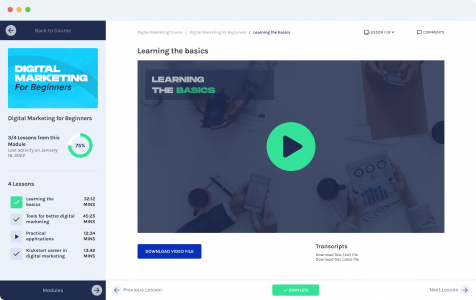We've scoured the latest research to bring you up-to-date membership site statistics and insights into the growing subscription trend.
Contents
The rise of the creator landscape has opened doors for innovators to monetize their unique ideas. With tools like WishList Member, launching a membership site is more accessible than ever.
Having a comprehensive set of membership site statistics can give you the confidence to navigate the evolving landscape.
There's a vast array of membership sites out there. In this article, we zoom in on three defining categories in the industry:
- Educational Platforms (Learning Management Systems)
- Association Membership Models
- Subscription-Based Platforms
This information will not only guide your marketing efforts but also offer a peek into future trends in your niche.
Ready to get going? Let the numbers commence!

Learning Management Systems (LMS) Stats
An increasing number of companies are turning to learning management systems (LMS) to develop online educational platforms or incorporate educational elements into their membership sites. It's an effective strategy to enhance your business's value and expand its offerings.
CourseCure, the integrated LMS within WishList Member ensures a seamless and efficient setup. It's backed with features to help you quickly and easily set up an engaging course to add to your membership site.

Now, let's delve into the LMS platform market.
- A 2023 market research report by Fortune Business Insights revealed that last year the global LMS market size was valued at $16.19billion. This year it's expected to grow to $18.26 billion.
- By 2030, that number is projeced to grow to a massive $47.47 billion.
- The fastest growing market is Europe while the largest market is North America according to a report by Straits Research.
- Growth is attributed to improved internet connectivity, higher adoption of smartphone technologies in educational institutions and the increasing preference of consumers for LMSs.
- Over 40% of Fortune 500 companies use elearning or LMSs to onboard and train employees according to eLearning Industry.
- LMS users use the following devices to access their online courses: desktop (89%), laptop (76%), tablet (25%), and smartphone (19%). This suggests a necessity for LMSs to be responsive in order to cater to the various preferences of students.
- The top-requested LMS functionalities between 2022-2023 were certification and compliance management (53%), content authoring (15%) and course libraries (15%). (Capterra)
- The average LMS software budget ranges between $15-$40 per user.
Association Membership Statistics

Associations typically represent smaller entities dedicated to a specific profession, trade, or philanthropic cause. They often collaborate with individual member organizations, trade collectives, or a blend of both.
The primary purpose of these associations is to foster knowledge exchange, promote best practices, expand member networks, and champion their members' interests.
Unlike mainstream businesses, association membership organizations cater to a distinct audience with specialized needs.
The ethos of each association is often shaped by its industry or cause. Now, let's explore some valuable insights to enhance association marketing and bolster member recruitment.
- The top reasons people join associations are: networking opportunities (64%); continued education (39%) and learning best practices in their profession (33%).
- 49% of associations reported an increase in membership in 2023, up from 38% in 2022, and 26% in 2021, showing a sharp upward trend in membership uptake over the past 3 years.
- In 2023, used the following channels to recruit new members: email (85%), organic social media (67%) and association-sponsored events (66%).
- The top reasons associations believe prospects are not signing up for membership are: lack of perceived value (60%), lack of brand awareness (39%), lack of financial support from employers (29%).
- 34% of associations invite members to join their online community as a way of engaging existing members.
- 48% of associations give members a 2-3 month grace period for accessing benefits after their membership expires.
- Engagement is the most common challenge for associations with 51% equating lack of engagement with the reason why members failed to renew.
- Innovation is key when it comes to member attainment and retention. However, only 25% of associations reported as very or extremely innovative. (Marketing General)
- 13% of associations that added, altered, or canceled events observed an increase in member engagement, indicating that it's important to adjust your strategy. (GrowthZone)
- 60% offer their members automatic annual payments, 14% offer automatic monthly payments, but only 26% offer both options in 2023.
- Only 38% have a process in place to reengage churned members.
Subscription Model Statistics

Subscription businesses and services are popping up everywhere, and for good reason. Who doesn't love predictable cashflow and customer loyalty?
Not only that, but consumers are also fast catching on to the convenience of subscriptions over outright ownership. It's no wonder this model is catching on big time.
Let's delve into some pivotal statistics defining the subscription economy. These numbers will show you why everyone's hopping on the subscription train and why it's poised to dominate over the coming years.
- A report early this year valued the digital subscription market at $650 billion.
- By 2025 it's set to grow to $1.5 trillion according to the latest estimates. (Lineup)
- 205 million Americans report using at least one subscription service, marking a 23 million increase since 2020.
- By the end of this year, three quarters (75%) of direct-to-consumer brands are projected to offer subscription services. (RetailDive)
- Millennials and bridge millennials lead the way in subscribing to retail products, with 39% subscribing to at least one.
- The average growth of subscription billing vendors stands at between 30% and 50% annually. (The Paypers)
- According to a survey by Global Banking and Finance, 70% of senior business leaders in key industries including retail and finance believe subscription models are key to growth.
- 53% of senior finance executives surveyed by the CFO reported hat 40% of their business revenue comes in via a subscription product or service.
- Over three quarters of businesses say that their subscription service improves customer retention and builds loyalty.
- Global adoption of the subscription economy is at about 16%, targeted to grow at 30%. (Citi)
- By 2027, a projected 83% of U.S. households will no longer subscribe to a traditional television service. (Leichtman)
Tips & Best Practices: What Have We Learned?
Alright, that wraps it up! Hopefully, you've picked up some solid info on the membership game by checking out those three membership types.
There are also plenty of insights to help you switch up your strategy and make better decisions and optimize your membership site. Here are just a few of the tips and best practices we've uncovered:
1. LMS (Learning Management Systems) Best Practices:
- Gamify Your Content: With the rise in popularity of e-learning, it's essential to stand out. Incorporate gamification features like points, badges, and quizzes to make your courses more engaging and interactive. Choose a course builder that incorporates these features (such as CourseCure for WishList Member)
- Maintain Content Control: Ensure your LMS gives you full control over your content. Being able to make real-time updates, additions, or changes is crucial to adapt to the evolving needs of your audience.
- Prioritize Responsiveness: The statistics show a diverse range of devices being used to access courses. Opt for LMS solutions that are responsive, ensuring a seamless experience whether your members are on desktops, laptops, tablets, or smartphones.
2. Association Membership Best Practices:
- Value-Driven Engagement: Given that networking opportunities are a top reason people join associations, consider hosting regular webinars, virtual meet-ups, or forums to facilitate this need.
- Tailored Marketing: With a sharp upward trend in membership uptake over the past 3 years, it's essential to understand your audience. Use targeted marketing strategies based on the specific needs and preferences of your potential members.
- Re-Engagement Strategies: Since only 38% have a process to reengage churned members, develop a strategy to bring back those who've left. This could be through special offers, feedback surveys, or highlighting new benefits.
3. Subscription Model Best Practices:
- Diversify Payment Options: Given the varied preferences for payment frequencies, offer multiple subscription payment options, from monthly to annually, to cater to different member needs.
- Stay Ahead with Trends: With the digital subscription market projected to grow immensely, keep an eye on emerging trends. This will help you adapt your offerings and stay competitive.
- Focus on Retention: With over three-quarters of businesses saying subscription services improve customer retention, invest in strategies that boost loyalty. This could be through exclusive content, member-only discounts, or regular feedback loops.
By implementing these best practices, you'll be better positioned to maximize the potential of your membership site, whether it's an LMS, an association membership, or a subscription-based platform.
In Summary
It's clear as day: the subscription world is booming and shows no signs of slowing down. Thinking of launching an online course or adding some steady cash flow to your shop? There's no better time than now.
Remember, it's all about offering a quality service that makes life easier for your members. Do that, and you'll see your profits climbing each year.
And hey, start with the right tools to make setting up and managing your membership site a breeze.
Found this blog useful? Follow us on Twitter, Facebook, YouTube, and LinkedIn for more tips and best practices to make the most of your WordPress membership site.

















This Post Has One Comment
Great info thanks!